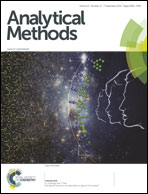Redox behavior and adsorptive cathodic stripping voltammetric determination of nanomolar levels of palladium using a novel Schiff base reagent containing a squaric acid moiety
Abstract
The redox behavior of a palladium(II)-3,4-bis(2-hydroxyphenyl-imino) cyclobut-1-en-1,2-diol complex at Pt, Au and hanging mercury drop electrodes (HMDE) was studied for developing a low cost and precise method for determination of Pd concentration in road dust and other environmental samples. Hence, a controlled adsorptive accumulation of this complex on HMDE provided the basis for adsorptive cathodic stripping voltammetric (AdCSV) measurements of palladium at nanomolar levels at pH 9–10 and at −0.64 V vs. the Ag/AgCl reference electrode. The calibration plot was obtained in the range of 1.87 × 10−9 to 3.05 × 10−7 M (0.2 to 32.5 μg L−1) Pd. The limit of detection was found to be 4.70 × 10−10 M (0.05 μg L−1), with a relative standard deviation (RSD) of ±2.1% (n = 5) at 2.0 μg L−1 Pd level. Common anions and cations did not interfere in the determination of Pd concentration. The method was applied to the determination of the concentration of Pd in pure authentic samples, roadside dust and water samples. The method offers a simple system coupled with good reproducibility, accuracy, ruggedness and cost effectiveness.


 Please wait while we load your content...
Please wait while we load your content...